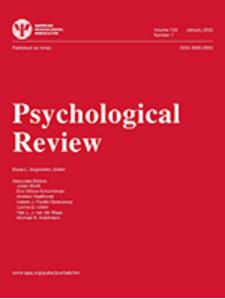Perception and simulation during concept learning.
IF 5.1
1区 心理学
Q1 PSYCHOLOGY
引用次数: 0
Abstract
A key component of humans' striking creativity in solving problems is our ability to construct novel descriptions to help us characterize novel concepts. Bongard problems (BPs), which challenge the problem solver to come up with a rule for distinguishing visual scenes that fall into two categories, provide an elegant test of this ability. BPs are challenging for both human and machine category learners because only a handful of example scenes are presented for each category, and they often require the open-ended creation of new descriptions. A new type of BP called physical Bongard problems (PBPs) is introduced, which requires solvers to perceive and predict the physical spatial dynamics implicit in the depicted scenes. The perceiving and testing hypotheses on structures (PATHS) computational model, which can solve many PBPs, is presented and compared to human performance on the same problems. PATHS and humans are similarly affected by the ordering of scenes within a PBP. Spatially or temporally juxtaposing similar (relative to dissimilar) scenes promotes category learning when the scenes belong to different categories but hinders learning when the similar scenes belong to the same category. The core theoretical commitments of PATHS, which we believe to also exemplify open-ended human category learning, are (a) the continual perception of new scene descriptions over the course of category learning; (b) the context-dependent nature of that perceptual process, in which the perceived scenes establish the context for the perception of subsequent scenes; (c) hypothesis construction by combining descriptions into explicit rules; and (d) bidirectional interactions between perceiving new aspects of scenes and constructing hypotheses for the rule that distinguishes categories. (PsycInfo Database Record (c) 2023 APA, all rights reserved).概念学习过程中的感知和模拟。
人类在解决问题方面惊人创造力的一个关键组成部分是我们构建新颖描述的能力,以帮助我们描述新颖的概念。Bongard问题(BP)向问题解决者提出了一个区分分为两类视觉场景的规则,它为这种能力提供了一个优雅的测试。BP对人类和机器类别学习者来说都是具有挑战性的,因为每个类别只呈现少数示例场景,而且它们通常需要开放式创建新的描述。介绍了一种称为物理Bongard问题(PBPs)的新型BP,它要求求解者感知和预测所描绘场景中隐含的物理空间动力学。提出了可以解决许多PBP的结构感知和测试假设(PATHS)计算模型,并将其与人类在相同问题上的表现进行了比较。PATHS和人类同样会受到PBP中场景顺序的影响。当场景属于不同类别时,在空间或时间上并置相似(相对于不相似)场景促进了类别学习,但当相似场景属于同一类别时,阻碍了学习。PATHS的核心理论承诺是(a)在类别学习过程中对新场景描述的持续感知;(b) 感知过程的上下文相关性质,其中感知的场景为后续场景的感知建立了上下文;(c) 通过将描述组合成显式规则来构建假设;以及(d)感知场景的新方面和为区分类别的规则构建假设之间的双向交互。(PsycInfo数据库记录(c)2023 APA,保留所有权利)。
本文章由计算机程序翻译,如有差异,请以英文原文为准。
求助全文
约1分钟内获得全文
求助全文
来源期刊

Psychological review
医学-心理学
CiteScore
9.70
自引率
5.60%
发文量
97
期刊介绍:
Psychological Review publishes articles that make important theoretical contributions to any area of scientific psychology, including systematic evaluation of alternative theories.
 求助内容:
求助内容: 应助结果提醒方式:
应助结果提醒方式:


